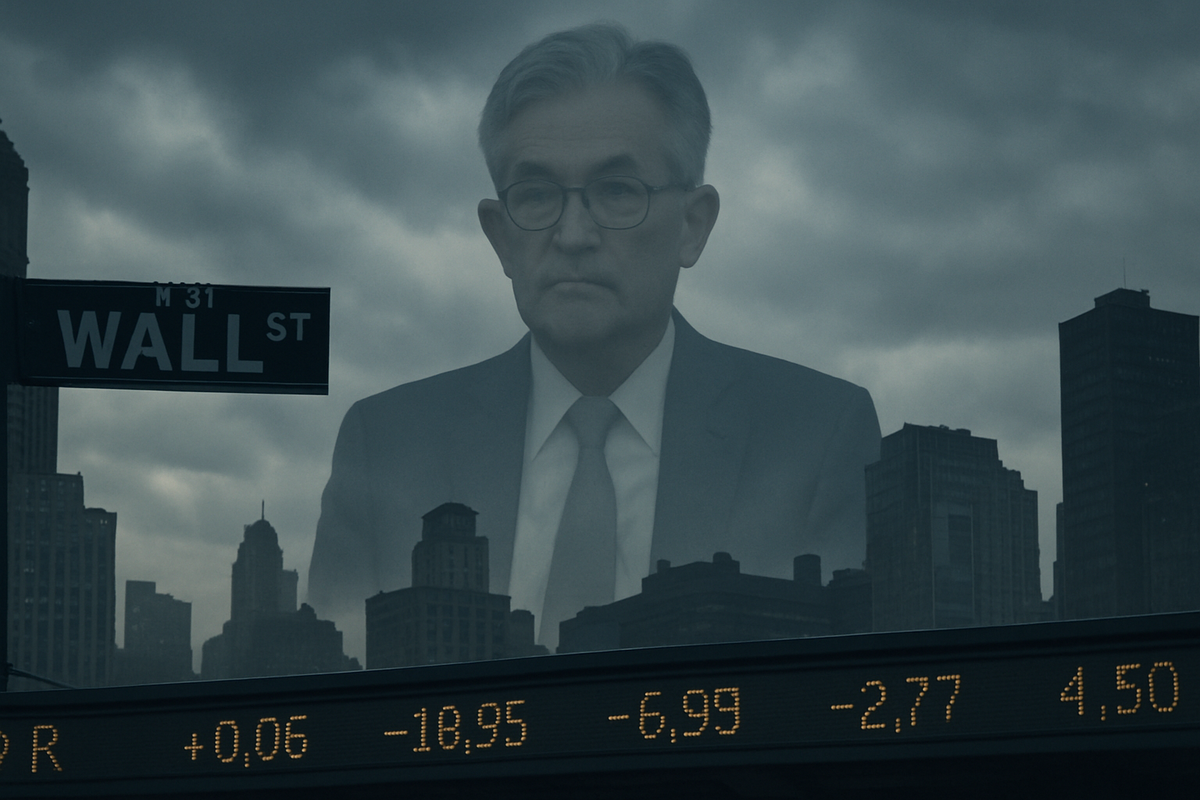
Wall Street is currently gripped by a palpable "wait-and-see" sentiment, as investors adopt an overwhelmingly cautious stance ahead of Federal Reserve Chair Jerome Powell's highly anticipated speech at the Jackson Hole Symposium. This pervasive mood has led to muted trading activity across major indices, reflecting a deep-seated reluctance among market participants to commit to significant positions before clearer signals emerge from the nation's central bank. The immediate implication is a market treading water, poised for potential volatility depending on the nuances of Powell's remarks.
This period of quiet anticipation underscores a broader uncertainty permeating the financial markets. With mixed economic data, persistent inflation concerns, and a backdrop of geopolitical tensions, investors are seeking definitive guidance on the Federal Reserve's future monetary policy path. The market's current equilibrium is fragile, with any unexpected pronouncements from Powell capable of triggering sharp shifts in asset prices and investor confidence.
The Pre-Powell Pause: Why Wall Street is on Edge
The current state of inertia on Wall Street is a direct consequence of the impending speech by Fed Chair Jerome Powell at the Jackson Hole Symposium. This annual gathering of central bankers, finance ministers, academics, and financial market participants is renowned for setting the tone for future monetary policy. Investors are keenly focused on Powell's address, hoping for definitive clues regarding the timing and magnitude of potential interest rate adjustments.
The timeline leading up to this moment has been characterized by a series of economic indicators that have painted a somewhat contradictory picture. While inflation has shown signs of moderating, it remains above the Fed's target, and the labor market, though cooling, has demonstrated resilience. This ambiguity has fueled speculation about the Fed's next move, with futures traders currently pricing in a high probability (around 83-84%) of a September rate cut. However, the possibility remains that Powell might endorse a September cut but signal a slower easing cycle, or even defer judgment until more data becomes available. Any deviation from market expectations could lead to significant disappointment and market corrections.
Key players in this scenario include the Federal Reserve, led by Chair Powell, whose words carry immense weight in shaping market sentiment and economic trajectories. Investors, ranging from institutional funds to individual traders, are the primary stakeholders, their portfolios directly impacted by the Fed's decisions. Initial market reactions have been characterized by range-bound trading, with major U.S. indices like the Dow, S&P 500 (SPX), and Nasdaq (NDX) hovering near flatlines. Trading volumes have been notably quiet, indicating that many investors are choosing to remain on the sidelines rather than making aggressive moves, preferring to take profits in recently surging stocks driven by sentiment rather than robust fundamentals.
Navigating the Tides: Potential Winners and Losers in a Cautious Market
In an environment dominated by a "wait-and-see" sentiment, the potential for significant shifts in market leadership becomes pronounced. As investors brace for Fed Chair Powell's speech, dual strategies are emerging, focusing on both rate-sensitive sectors and geopolitical hedges. The outcome of Powell's address will largely dictate which sectors and companies emerge as winners or losers.
Should Powell signal a more dovish stance, hinting at imminent and sustained rate cuts, rate-sensitive sectors are poised for a rebound. Financials, particularly regional banks like KeyCorp (NYSE: KEY) and Zions Bancorporation (NASDAQ: ZION), which have been pressured by higher interest rates impacting their net interest margins, could see renewed interest. Similarly, real estate investment trusts (REITs) such as Simon Property Group (NYSE: SPG) and Prologis (NYSE: PLD), which benefit from lower borrowing costs and increased property demand, would likely experience a boost. Technology companies, especially those with high growth potential and reliance on future earnings, like NVIDIA (NASDAQ: NVDA) and Microsoft (NASDAQ: MSFT), often see their valuations improve in a lower-rate environment as the discount rate applied to their future cash flows decreases. Consumer discretionary companies, including retailers like Amazon (NASDAQ: AMZN) and Target (NYSE: TGT), could also benefit from increased consumer spending power if borrowing costs decline.
Conversely, a more hawkish tone from Powell, suggesting higher-for-longer rates or a slower easing cycle, would likely put pressure on these same rate-sensitive sectors. Banks might face continued margin compression, and growth stocks could see their valuations re-evaluated downwards. In such a scenario, sectors traditionally seen as defensive or less sensitive to interest rates might outperform. These include utilities, consumer staples, and healthcare. Companies like NextEra Energy (NYSE: NEE), Procter & Gamble (NYSE: PG), and Johnson & Johnson (NYSE: JNJ) offer stable dividends and consistent demand for their products, making them attractive during periods of uncertainty.
Beyond interest rate sensitivity, the current geopolitical landscape is prompting investors to consider hedges. In times of global instability, traditional safe-haven assets tend to perform well. Gold, often seen as a store of value, and companies involved in its mining, such as Barrick Gold (NYSE: GOLD), could see increased demand. Defense contractors like Lockheed Martin (NYSE: LMT) and Raytheon Technologies (NYSE: RTX) might also be viewed favorably due to increased government spending on defense. Furthermore, companies with strong balance sheets and robust free cash flow, regardless of sector, are generally better positioned to weather economic uncertainties.
Broader Implications: Shifting Tides in the Financial Landscape
The current "wait-and-see" sentiment on Wall Street, driven by anticipation of Fed Chair Powell's speech, is not merely a fleeting market mood; it represents a critical juncture that could significantly influence broader industry trends and ripple effects across the financial ecosystem. This event fits into a larger narrative of central banks grappling with persistent inflation while attempting to engineer a "soft landing" for the global economy.
The potential for a shift in monetary policy has profound implications for various industries. For instance, the housing market, which has been particularly sensitive to interest rate fluctuations, could experience a renewed surge in activity if rates decline, benefiting homebuilders like D.R. Horton (NYSE: DHI) and real estate agencies. Conversely, a prolonged period of high rates could continue to stifle demand. The automotive industry, reliant on consumer financing, would also feel the effects, with lower rates potentially boosting sales for manufacturers like General Motors (NYSE: GM) and Ford (NYSE: F).
The ripple effects extend to competitors and partners within these industries. For example, if lower rates stimulate consumer spending, it could benefit the entire retail supply chain, from logistics companies to payment processors. Conversely, if economic uncertainty persists, it could lead to tighter credit conditions, impacting smaller businesses and startups that rely on accessible capital.
From a regulatory and policy perspective, the Fed's stance will inevitably influence government fiscal policy. A more accommodative monetary policy might provide governments with more leeway for spending initiatives, while a restrictive stance could necessitate fiscal austerity. Historically, periods of significant monetary policy shifts, such as the Volcker era in the early 1980s or the quantitative easing programs post-2008, have led to dramatic reconfigurations of market dynamics and investment strategies. The current moment bears some resemblance to past periods of high inflation and central bank intervention, underscoring the need for adaptability among market participants. The outcome of Powell's speech could either reinforce the current disinflationary trend or signal a more entrenched battle against rising prices, shaping regulatory priorities around financial stability and consumer protection.
What Comes Next: Navigating the Post-Powell Landscape
The immediate aftermath of Fed Chair Powell's speech will undoubtedly set the tone for the short-term market trajectory. In the short-term, investors should brace for increased volatility, as markets digest and react to every nuance of his remarks. If Powell signals a clear path to rate cuts, we could see a relief rally, particularly in growth stocks and rate-sensitive sectors. Conversely, a hawkish stance could trigger a sell-off, pushing investors towards defensive assets. Beyond the initial reaction, the market will closely scrutinize subsequent economic data, including the August nonfarm payrolls report and the PCE price index, to confirm or contradict Powell's outlook.
In the long-term, the implications are more profound. A sustained period of lower interest rates could reignite economic growth, fostering an environment conducive to corporate expansion and innovation. This might lead to strategic pivots for companies, encouraging investment in capital expenditures and research and development. Conversely, a "higher-for-longer" rate environment could force companies to prioritize cost-cutting and efficiency, potentially leading to consolidation in certain industries. Market opportunities may emerge in sectors that demonstrate resilience or adaptability to the prevailing interest rate regime. For instance, if inflation proves sticky, commodities and inflation-protected securities could become attractive.
Potential scenarios and outcomes are varied. One scenario involves a "soft landing," where inflation gradually recedes without triggering a recession, allowing the Fed to ease policy incrementally. This would likely be the most favorable outcome for equities. Another scenario is a "hard landing," where aggressive rate hikes or persistent inflation lead to a significant economic downturn, prompting a more rapid and substantial easing cycle by the Fed, but only after a period of market distress. A third scenario involves a prolonged period of economic stagnation with elevated inflation, a challenging environment for most asset classes. Investors will need to remain agile, adapting their portfolios to these evolving macroeconomic conditions and the Fed's response.
Conclusion: A Market at the Crossroads
The current "wait-and-see" sentiment on Wall Street, preceding Fed Chair Powell's pivotal speech, encapsulates a market at a critical crossroads. The key takeaway is the profound uncertainty surrounding the Federal Reserve's future monetary policy, which is acting as a gravitational pull on investor activity. This period of caution highlights the market's sensitivity to central bank guidance and its potential to dictate the performance of various asset classes and sectors.
Moving forward, the market's trajectory will largely hinge on the Fed's ability to navigate the dual challenges of inflation control and economic growth. Investors should be prepared for continued volatility and potential shifts in market leadership. The emphasis on dual strategies—considering both rate-sensitive sectors and geopolitical hedges—underscores the need for diversified and adaptable portfolios in the current environment.
In the coming months, investors should closely watch for several key indicators. Beyond the immediate reaction to Powell's speech, attention will turn to subsequent inflation data, particularly the Consumer Price Index (CPI) and Personal Consumption Expenditures (PCE) price index, as well as labor market reports like nonfarm payrolls and unemployment rates. Corporate earnings reports will also provide crucial insights into the health of the economy and consumer spending. Finally, any further geopolitical developments will continue to influence risk sentiment. The ability to interpret these signals and adjust investment strategies accordingly will be paramount for navigating the evolving financial landscape and capitalizing on emerging opportunities.





